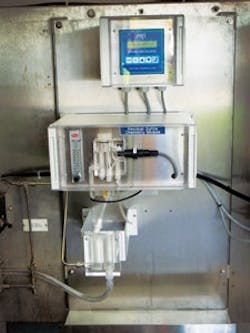Soft Drink Supplier Monitors Hydrogen Sulfide in Bottled Drinking Water
Britvic Soft Drinks Ltd. is one of the U.K.’s largest suppliers of branded still soft drinks and branded carbonates. Based in Chelmsford, Essex, U.K., the company operates seven manufacturing sites across the U.K., producing a range of brands, including Pepsi, Tango, Robinsons and J2O.
Britvic’s Huddersfield factory is a water bottling facility operating two boreholes—one classified as spring water and the other as mineral water. The site houses two high-speed water bottling production lines operating 24 hours a day, six days a week.
According to current legislation, the quality of water produced at the Huddersfield factory must be monitored for manganese, barium and mineral content. Retention samples also must be taken at regular intervals to ensure that microbiological levels are within specification. Britvic recently worked with Analytical Technology to implement effective monitoring controls for hydrogen sulfide (H2S) that would enable accurate measurement as well as compliance with strict regulations.
Meeting Regulations
Bottled water in the U.K. is controlled by the Natural Mineral Water, Spring Water, and Bottled Drinking Water Regulations (England) 2007. The regulation specifies that bottled water should not contain any microorganism, parasite, property, element or substance at a concentration or value that would constitute a potential danger to human health.
Britvic required reliable instrumentation that would enable accurate monitoring of soluble H2S levels in water that comes directly from each of the boreholes, after processing through air scrubbers/degasser towers and after manganese filtration.
Sulfide Solution
The measurement of dissolved sulfide concentrations traditionally has been performed using analyzers employing selective ion electrodes (SIE) for sensing. While they provide adequate sensitivity, SIE-based systems require frequent zero and span adjustments to maintain measurement accuracy. As a result, most SIE-based monitoring systems are relatively expensive and require frequent service.
Britvic selected the A15/81 dissolved sulfide monitor from Analytical Technology because it can monitor soluble H2S in water on a real-time basis. The system overcomes the problems caused by conventional dissolved sulfide monitoring systems, providing an improved method for measuring sulfides in solution. Rather than using an SIE sensor, the A15/81 employs a polarographic H2S gas sensor that is isolated from the sample, enabling continuous operation on many types of water and wastewater streams with minimal maintenance and adjustment. As sulfide measurements often are taken from poor-quality samples, analytical system fouling can be a major concern. For Britvic, an advantage of the A15/81 monitor is that the sensor does not come into contact with the sample. Only the gas stream containing the stripped H2S reaches the sensor. Therefore, the system continues to function regardless of the quality of the sample. The A15/81 measures sulfide ions selectively by conversion to H2S. Monitoring sulfides in solution using the gas-stripping technique provides high measurement sensitivity, allowing for measurement of samples down to 5 parts per billion. Because the gas sensor is stable, monthly zero and span checks are all that are needed. A separate port is provided to feed distilled water or sulfide standards when required, without disrupting normal sample inlet flow.
Since implementing the monitors, Britvic has been able to ensure that its bottled products are accurately and continuously monitored for H2S. The company has achieved this goal while also ensuring that costs and maintenance are kept to a minimum and reliable results are generated in real time.
